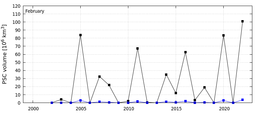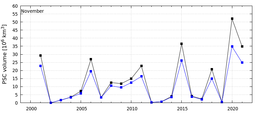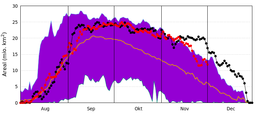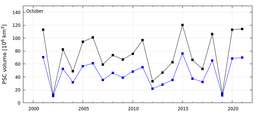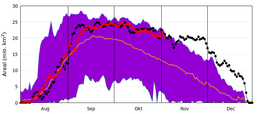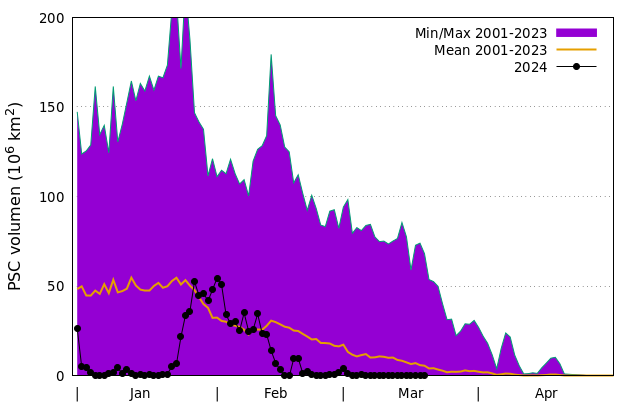
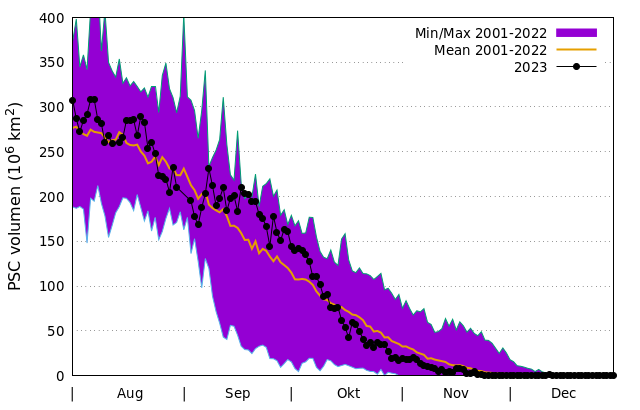
RO PSC volumes
We here present results of a study initiated as part of the Danish National Centre for Climate Reseach (NCKF).
The objective of this study to investigate polar stratospheric conditions relevant for ozone depletion studied with Radio Occultation (RO) data.
The focus in the first phases will be on the temperature trends in the stratosphere and the volume in the atmosphere where polar stratospheric clouds (PSC) form during the polar winter. PSCs and ozone depletion is tightly connected.
The purpose of this study is a) to investigate methods for quantifying the volume,VPSC, from GNSS-RO stratospheric temperature and pressure data, and b) to investigate the long-term variability and trends of stratospheric temperatures conducive to the formation of PSCs. The objectives with these investigations are to further our understanding of role played by climate change for the evolution of ozone-depleting conditions in the Arctic, but also to lay the foundations for an operational service at DMI to monitor these conditions as they evolve day by day during the winter-spring seasons in the Arctic and Antarctic.
At present we present daily updated temperature measurements in the stratosphere and volume of PSC-forming areas over the polar regions. At a later stage additional results on PSC and vortex will be included.
05/02/22
Older news
Arctic:
The 2021-2022 winter season in the Arctic showed a large and stable polar vortex. The low temperature areas where formation of PSCs are possible were present from late November to medio March. The PSC volumes where large especially in February where the monthly average PSC volume was the largest seen in this data record starting 2002. The PSC area diminished during the last part of February and a large but not record breaking ozone depletion is to be expected. More news when the data on ozone depletion of the season is available.
You can find the monthly averaged PSC volumes and follow the daily temperatures and PSC volumes in the menu on the left.
12/03/21
3-12-2021
Antarctica:
The average PSC volume for November is now available, as expected it is large. For the first half of the month, the situation was rather similar to last year, as it has been since August. During the last weeks of November, the cold area was shrinking considerably. However, the result was the 3rd largest average PSC volume for November since 2001. The increase in temperatures means that PSCs do not form and thus further ozone depletion is stopped. The size of the ozone hole is still rather big for the season, because the polar vortex is still stable and shields the air inside from mixing with ozone rich air from the mid latitudes.
Next up: The northern hemisphere is now taking over the focus. The PSC volume is slowly increasing and the vortex stabilizing.
You can follow the daily temperatures and PSC volumes in the menu on the left.
4-11-2021
Antarctica:
We have now calculated the average PSC volume for October, and as expected from the previous months it is large. A bit larger than last year and only a bit smaller than the top record from 2015. This years ozone hole seems so far to duplicate the 2020 version, this is exiting because in 2020 it set a new record from mid November and all through December.
You can follow the daily temperatures and PSC volumes in the menu on the left.
Next up: The polar vortex over the Arctic is beginning to take form, the temperatures are dropping, thus the PSC season is slowly starting in the northern hemisphere. We shall follow it closely.
This site is still in the development phase.
Contacts: Helge Jønch-Sørensen (hjs@dmi.dk) and Hans Gleisner (hgl@dmi.dk)

